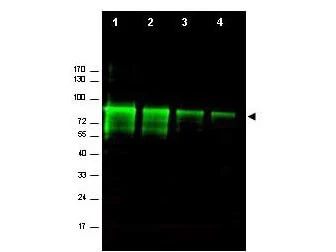![Western blot using GeneTexs Affinity Purified anti-Mre11 antibody shows detection of a band ~80 kDa corresponding to mouse Mre11 (arrowhead). Lanes 1-4 contain 0.5 microg, 0.3 microg, 0.1 microg and 0.05 microg of purified mouse Mre11 protein, respectively. After 4-20% SDS-PAGE and transfer onto nitrocellulose, the membrane was blocked and then probed with the primary antibody diluted to 1:1,000 overnight at 4oC. The membrane was then washed and reacted with a 1:10,000 dilution of IRDye800 conjugated goat anti-Rabbit IgG [H&L] MX for 45 min at room temperature. IRDye800 fluorescence image was captured using the OdysseyR Infrared Imaging System developed by LI-COR. IRDye is a trademark of LI-COR, Inc. Other detection systems will yield similar results. Western blot using GeneTexs Affinity Purified anti-Mre11 antibody shows detection of a band ~80 kDa corresponding to mouse Mre11 (arrowhead). Lanes 1-4 contain 0.5 microg, 0.3 microg, 0.1 microg and 0.05 microg of purified mouse Mre11 protein, respectively. After 4-20% SDS-PAGE and transfer onto nitrocellulose, the membrane was blocked and then probed with the primary antibody diluted to 1:1,000 overnight at 4oC. The membrane was then washed and reacted with a 1:10,000 dilution of IRDye800 conjugated goat anti-Rabbit IgG [H&L] MX for 45 min at room temperature. IRDye800 fluorescence image was captured using the OdysseyR Infrared Imaging System developed by LI-COR. IRDye is a trademark of LI-COR, Inc. Other detection systems will yield similar results.](https://www.genetex.com/upload/website/prouct_img/normal/GTX48735/GTX48735_20160330_WB_w_23060823_965.webp)
Western blot using GeneTexs Affinity Purified anti-Mre11 antibody shows detection of a band ~80 kDa corresponding to mouse Mre11 (arrowhead). Lanes 1-4 contain 0.5 microg, 0.3 microg, 0.1 microg and 0.05 microg of purified mouse Mre11 protein, respectively. After 4-20% SDS-PAGE and transfer onto nitrocellulose, the membrane was blocked and then probed with the primary antibody diluted to 1:1,000 overnight at 4oC. The membrane was then washed and reacted with a 1:10,000 dilution of IRDye800 conjugated goat anti-Rabbit IgG [H&L] MX for 45 min at room temperature. IRDye800 fluorescence image was captured using the OdysseyR Infrared Imaging System developed by LI-COR. IRDye is a trademark of LI-COR, Inc. Other detection systems will yield similar results.
Mre11 antibody
GTX48735
Overview
- SupplierGeneTex
- Product NameMre11 antibody
- Delivery Days Customer9
- Application Supplier NoteWB: 1:500-1:2000. ELISA: 1:10000-1:50000. *Optimal dilutions/concentrations should be determined by the researcher.Not tested in other applications.
- ApplicationsWestern Blot, ELISA
- CertificationResearch Use Only
- ClonalityPolyclonal
- Concentration1.05 mg/ml
- ConjugateUnconjugated
- Gene ID17535
- Target nameMre11a
- Target descriptionMRE11A homolog A, double strand break repair nuclease
- Target synonymsdouble-strand break repair protein MRE11; double-strand break repair protein MRE11A; meiotic recombination 11 homolog 1; meiotic recombination 11 homolog A; mmMRE11A; Mre11; MRE11 homolog 1; MRE11 homolog A; Mre11b
- HostRabbit
- IsotypeIgG
- Protein IDQ61216
- Protein NameDouble-strand break repair protein MRE11
- Scientific DescriptionMre11 is a component of the MRN complex (Mre11/Rad50/Nbs1), which plays a central role in double-strand break (DSB) repair, DNA recombination, maintenance of telomere integrity and meiosis. The complex possesses single-strand endonuclease activity and double-strand-specific 3-5 exonuclease activity, which are provided by MRE11A. RAD50 may be required to bind DNA ends and hold them in close proximity. This could facilitate searches for short or long regions of sequence homology in the recombining DNA templates, and may also stimulate the activity of DNA ligases and/or restrict the nuclease activity of MRE11A to prevent nucleolytic degradation past a given point. The complex may also be required for DNA damage signaling via activation of the ATM kinase. In telomeres the MRN complex may
- ReactivityMouse
- Storage Instruction-20°C or -80°C,2°C to 8°C
- UNSPSC12352203

